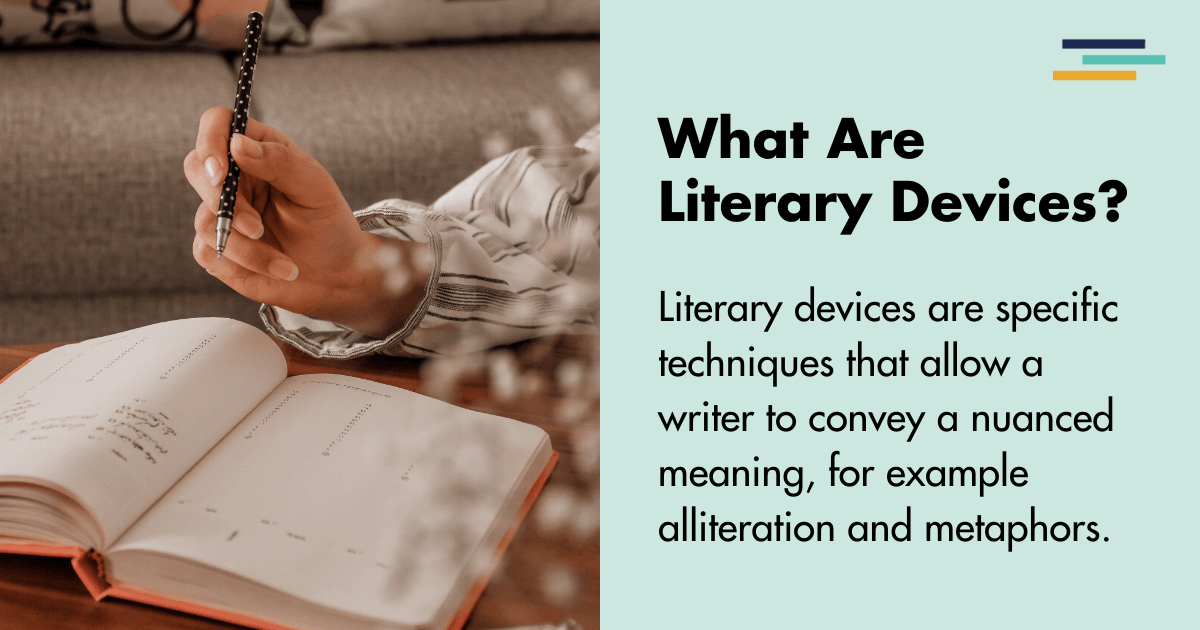
Literary elements are the building blocks of great stories. They are essential. If any of these pieces are missing, there will be no story.
Great news! If you are a reader or student of story, these will help you unlock understanding. If you are a writer, they offer opportunities.
Let’s dive in and discover how these pieces can be used to reveal the full picture, just like a jigsaw puzzle.
What Are Literary Devices?
There can be confusion with any technical jargon. Yup, I said it. Elements, devices, techniques are all subject specific words. And that’s jargon. So let’s dig in and get clear on these terms to give us a shared understanding to build on.
Elements are the big bits that a story must have to be considered a story. So what would that include? At the most basic, a story is about someone, or something, doing something somewhere. Characters acting out a plot in a setting. So, what else is essential?
We expect some kind of structure for our story: a beginning, middle, and end. We are including some author choices that create the reading experience and meaning like theme, voice, and point of view.
Devices is the broadest term. Any specific aspect we look at closely, whether we recognize, identify or analyze, is a device. Elements and techniques fall under the umbrella of devices.
Techniques are what the writer uses to express themselves which can include techniques focused on language, like metaphors, and techniques focused on narrative, like flashbacks, backstory, and foreshadowing.
The easy way to think about the difference between elements and techniques is that elements are necessary to a story, techniques are optional. Both create a unique story and understanding them can make both reading and writing even more fun.
Let’s start with literary elements.

Literary Elements List: 8 Essentials
Let’s start with the big three. They are the parts of our first definition of a story: character, plot, and setting.
3 Key Elements
Character
The readers follow the characters in a story. The characters don’t need to be human. These beings drive the story forward, do the actions, and have the feelings. It is their motivation, struggles and thoughts that the reader follows throughout the story.
These could be animals, like those in George Orwell’s Animal Farm, humans like the characters in Jane Austen’s Pride and Prejudice, or any other being, like the hobbits and others in J.R.R. Tolkien’s Lord of the Rings trilogy.
However unique or unusual, the characters in a story are the avatars for the humans reading that story. Creating connection through motivations, emotions and reactions help the reader become immersed in the characters.
This offers the readers the unique opportunity to experience the world as someone or something else. That is the magic of reading. Where else can we find ourselves deeply inside someone else’s perspective?
Plot
What happens in the story is the plot. The writer creates a chronology of events.Without the plot, you wouldn’t have a story. From an action packed thriller like The Bourne Identity to the development of a relationship in a romance like The Duke and I, stories have action.
The action is driven by the character’s external story goal. What do they want? The plot develops as the protagonist strives to attain that goal. For example, Sherlock Holmes must solve a mystery or Katniss Everdeen must survive the Hunger Games.
If someone asks what a story is about, you will usually give a summary of the plot.
Another easy way to find the goal of the story is to consider the central conflict in the story. This is the struggle between opposing forces which is the driving force of the story. The outcome of the story provides the resolution of the conflict. The conflict also sets up what is at stake for the character if they don’t achieve the story goal. What will happen if they lose?
For Sherlock Holmes, the murderer will get away and could kill again. For Katniss Everdeen, she will die and leave her family without the support they need to survive as well.
In Fictionary, these elements become the Skeleton Story Blurb. This simple statement captures these essential elements and helps you see that every scene in your story is essential for this story. The skeleton blurb is summed up as: The protagonist must (story goal) otherwise (story stakes). How easy is that?
So, there are characters doing things but there is still one major element missing, setting.
Setting
Setting creates the story world through time and place.
Some stories take place over a set time. Authors can use a short time span to create tension. From Ulysses by James Joyce to The Sun is Also a Star by Nicola Yoon, authors have used the constraint of a single day to heighten the tension and play with the pace of their story.
Other novels span decades to give a sweeping saga of a story. James Michener was well known for his epic historical stories. Readers get hints in the titles of some books: One Day in the Life of Ivan Denisovich or One Hundred Years of Solitude.
Where the story is set is also essential. While people often think of world-building in terms of the fantasy and historical fiction genres, place plays a vital role in all stories. Imagine Anne without Green Gables or Catherine and Heathcliff anywhere by Wuthering Heights.
Powerful stories give you the sense that It couldn’t happen anywhere else – or at any other time.
The setting is a powerful element that can set the mood, create conflict and offer the main backdrop for the story.
In Fictionary, these three elements are called the Supergroups. All the other Fictionary editing elements are found under these three headings.
Literary Element List: 3 Story Structure Elements
Structure
Structure is the way a story is assembled. This is anything with a clear organizational pattern. Every work has a structure of some sort. Sometimes it is new and original, but usually it is known.
Some familiar structures include the hero’s journey and the three act structure. There are many articles and books on story structure including beat sheets like Save the Cat and Romancing the Beat.
After much research, Kristina Stanley created the Fictionary Story Arc. This structure includes five key story arc scenes that are essential to a strong story structure. Using this simpler structure, a writer can add beats and additional subplots with the confidence that the core of their story is strong.
Point of View
A reader experiences the story through a particular character or narrator for every scene.
In some novels, there will be a single point of view character that the reader stays with throughout the story. First person narratives often have this singular focus. It is popular in many modern YA books as the reader can closely relate with the protagonist. This is a classic choice to create a close and limited perspective for the reader, as in Rebecca by Daphne du Maurier.
Other novels use a variety of point of view characters. This widening of the reader’s experience can create tension as the reader knows more than the protagonist.
A mystery novel may include scenes from the murderer’s point of view to heighten the fear for the protagonist. Romance novels often focus on the two love interests’ points of view to give the reader a sense of anticipation as characters actions may not convey their inner feelings.
If a story is written in first person, there will be a single point of view through which the reader experiences the story, if only for a scene. There are more stories being written that have more than one character using first person narration.
The Sun Is Also A Star includes chapter titles of the character names to make the switch in point of view clear for the reader. A Song of Ice and Fire by George R. R. Martin has multiple first person narrators.
Genre
Literature is divided up into types or genres. The major divisions are into drama, poetry, and fiction. Fiction can be further divided, usually by length or content. Length divisions include novels, novellas,, and short stories. Content genres can include mystery, romance, and fantasy for example.
Here we are going to focus on content genres as they develop reader expectations. When you pick up a romance book, you want to get to the “happily ever after” moment. As a reader of horror, you want monsters and a sense of terror. Each content genre has specific elements or conventions that will be expected by the reader.
Understanding these elements can help a writer develop a story that meets the readers’ expectations for the genre or that challenges those expectations.

Literary Element List: 2 Elements for the Author’s Style
Theme
With a strong theme, a story and the characters become memorable. The main idea or message conveyed by the story helps the readers get a sense of deeper understanding of the characters and a sense of reflection about the possible impact of the theme in their own lives.
While the theme is often conveyed indirectly in the story, the reader can generally express it as a full sentence.
While the writer may have one theme at the forefront of their thinking, the readers may discover other themes within the book that resonate personally. That is the wonderful aspect of this element. Every person will bring themselves, their experiences, and understanding to their awareness of the themes in a book.
For example, in The Hunger Games, the reader can find the themes of survival, rebellion, and interdependence. The reader may instead focus on the theme of love and family or self-sacrifice. Theme brings so much depth to the story.
Voice
Finally, essential to the story is the voice. What is this? Voice captures the author’s use of language, tone, imagery to create their own style.
Think about some of your favorite authors. Whether Stephen King is writing a short story like Shawshank Redemption or a novel like Carrie, there is a unique voice to his writing.
Let’s look at some aspects that help us understand this element.
Language
Of course, writers use language. But how? Think about the use of short or long sentences. The integration of dialect or specific description. Voice is created in the decisions an author makes about how they use language in their story.
Some writers create a new language for characters in their stories. In A Clockwork Orange, Anthony Burgess created a whole new language for the teens called Nadsat. In 1984, George Orwell described Newspeak.
Tone
Similar to tone of voice when speaking, tone is the emotion or attitude expressed in the writer’s voice. Often, the reader will sense the tone without being conscious of it.
This is where the writer can use tone to create a connection between the reader and the character, to create emotional distance from a character, to create questions or trust. This aspect of voice has many different possibilities.
Imagery
Writers use language to convey their world and characters. In helping the reader become immersed in the world, writers use language to describe the senses. This is imagery.
Imagery helps you follow that age old advice of show don’t tell. As you are reading, notice the moments you feel truly in the story world. Look for imagery there!
Let’s look at a quick example and then delve into a few literary devices authors may use to create their own voice.
Scott Fitzgerald shows the restless, aimless lives of Daisy and Jordan in this first description of the women as seen by Nick:
“The only completely stationary object in the room was an enormous couch on which two young women were buoyed up as though upon an anchored balloon. They were both in white, and their dresses were rippling and fluttering as if they had just been blown back in after a short flight around the house. I must have stood for a few moments listening to the whip and snap of the curtains and the groan of a picture on the wall. Then there was a boom as Tom Buchanan shut the rear windows and the caught wind died out about the room, and the curtains and the rugs and the two young women ballooned slowly to the floor.”
The images created by the visual of rippling and fluttering dresses and the sound of the whip, snap and boom create contrast between the restless movement of the women and the control that Tom exerts over them are powerful and clear.
What Are Literary Devices?
As mentioned above, literary devices is the broadest term for those aspects we examine as readers and writers. As well as the specific elements listed above, devices include those specific techniques as well as the broader ideas like internal character arcs and narrative strategy.
Literary Devices List
Here is a brief list of some literary devices to whet your appetite.
- Alliteration
- Backstory
- Flashback
- Foreshadowing
- Irony
- Metaphor
- Motif
- Simile
- Symbolism
Consider using these as inspiration for further exploration of literary devices.
Conclusion
Whether you are checking that you have the eight essential literary elements or examining how different literary devices are used in works that you read, understanding literary jargon can help express yourself and share your discoveries.
One great way to explore the use of devices in your own fiction writing is to explore them using the Fictionary app. As you fill in the Fictionary elements for each scene, you will discover your writing habits. You will be free to make informed choices as you create the best story for your readers.
As a reader, you can be aware of how different writers choose to integrate these essential literary elements into their work.
With all this knowledge, you are ready to start the conversation about what makes a story great for you. What stories do you love? Bet you know why!


